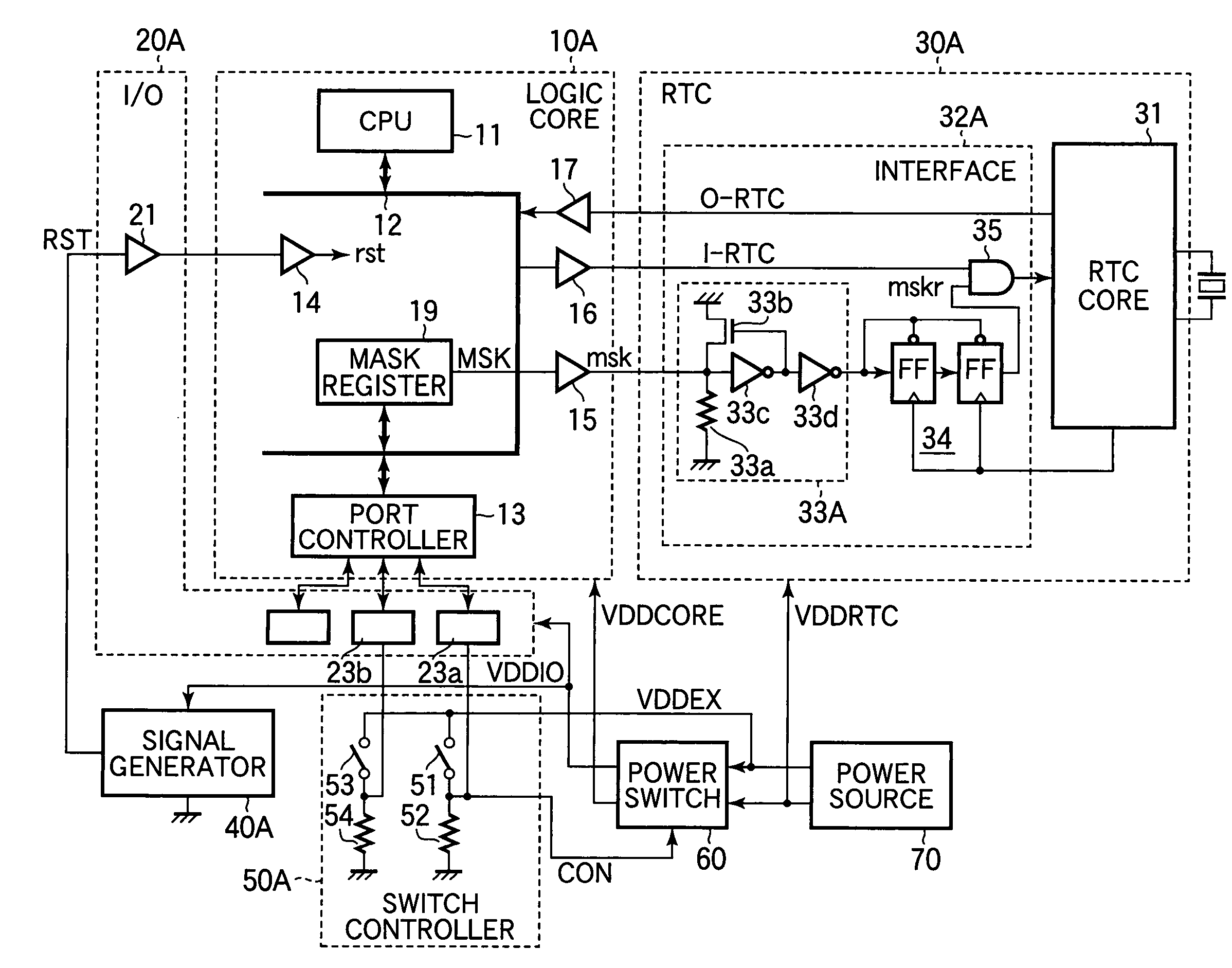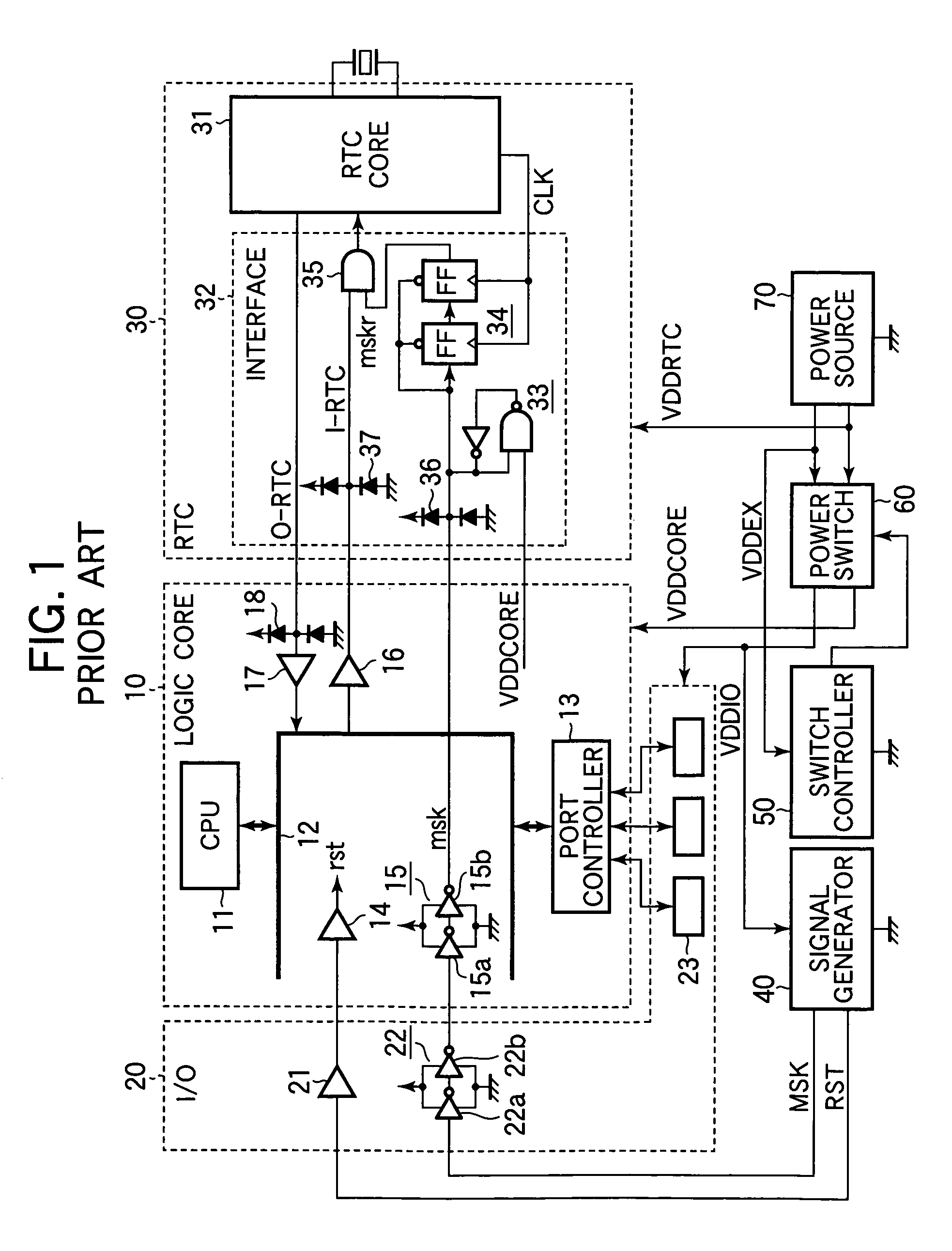Semiconductor circuit with mask register
a technology of semiconductor circuits and mask registers, applied in pulse generators, pulse techniques, instruments, etc., can solve the problems of large-scale integrated circuits that draw significant current, reduce the current consumption of these devices in standby state, and increase current that leaks through transistors in the off-state. to achieve the effect of improving reliability
- Summary
- Abstract
- Description
- Claims
- Application Information
AI Technical Summary
Benefits of technology
Problems solved by technology
Method used
Image
Examples
first embodiment
[0043]Referring to FIG. 2, the first embodiment is a semiconductor circuit comprising a large-scale integrated circuit, referred to below as an LSI chip, and external circuits connected to the LSI chip. The LSI chip includes a logic core 10A, an input-output section 20A, and a real-time clock counter or RTC 30A. The external circuits include a signal generator 40A, a switch controller 50A, a power switch 60, and a battery power source 70. The semiconductor circuit operates in a normal mode and a standby mode, referred to below as a battery backup mode.
[0044]The logic core 10A and input-output section 20A are disposed in a power-off area that receives power in the normal mode but not in the battery backup mode. The power supply voltage VDDCORE of the logic core 10A is substantially 1.5 V; the power supply voltage VDDIO of the input-output section 20A is substantially 3.3 V.
[0045]Like the logic core 10 in FIG. 1, the logic core 10A has a CPU 11, a system bus 12 connected to a port con...
second embodiment
[0075]FIG. 3 shows the RTC and its associated circuits in a second embodiment of the invention. The second embodiment differs from the first embodiment by replacing the logic core 10A and RTC 30A in the first embodiment in FIG. 2 with a modified logic core 10B and RTC 30B. The logic core 10B is modified by the addition of protective diodes 18 for the O-RTC signal line. The RTC 30B is modified by the addition of protective diodes 36, 37 for the mask (msk) and I-RTC signal lines, and an AND gate 38 that masks the O-RTC output signal when the synchronous mask signal (mskr) is low.
[0076]If there are multiple O-RTC signals, the second embodiment provides a separate AND gate 38 for each O-RTC signal line, each AND gate 38 receiving the synchronous mask signal (mskr) from the synchronizing circuit 34.
[0077]When the power of the power-off area is switched on, the logic core 10B and RTC 30B operate as described in the first embodiment, keeping the mask signals (MSK, msk, mskr) in the active ...
third embodiment
[0080]FIG. 4 shows the RTC and associated circuits in a third embodiment of the invention. The third embodiment differs from the second embodiment by replacing the RTC 30B in FIG. 3 with a modified RTC 30C in which the RTC core 31A has an additional state testing register 300. The state testing register 300 stores arbitrary data that can be read and written from the logic core 10B when the logic core 10B is powered and the mask is cleared. The RTC core 31A also includes a clock oscillator and further circuitry for generating time data as noted in the first embodiment.
[0081]The state testing register 300 is used as follows.
[0082]During power-up, after accessing the mask register and clearing the mask signal MSK as described in the first embodiment, the CPU in the logic core 10B writes a value other than zero in the state testing register 300, then reads the data in the state testing register 300. If the mask in the RTC 30C has been cleared (the synchronous mask signal mskr has gone h...
PUM
 Login to View More
Login to View More Abstract
Description
Claims
Application Information
 Login to View More
Login to View More - R&D
- Intellectual Property
- Life Sciences
- Materials
- Tech Scout
- Unparalleled Data Quality
- Higher Quality Content
- 60% Fewer Hallucinations
Browse by: Latest US Patents, China's latest patents, Technical Efficacy Thesaurus, Application Domain, Technology Topic, Popular Technical Reports.
© 2025 PatSnap. All rights reserved.Legal|Privacy policy|Modern Slavery Act Transparency Statement|Sitemap|About US| Contact US: help@patsnap.com



